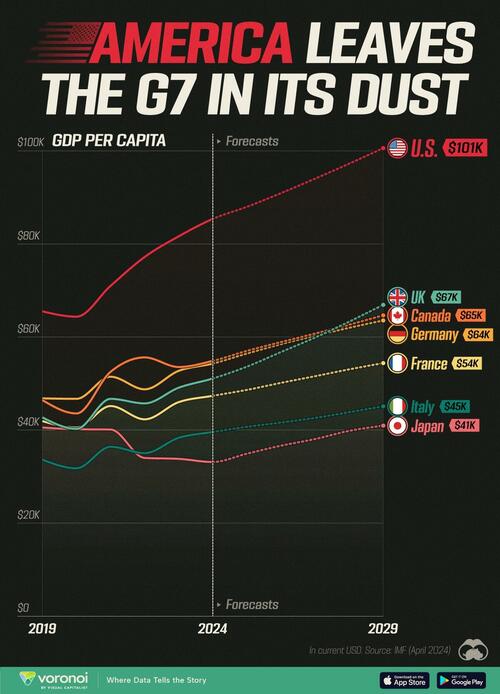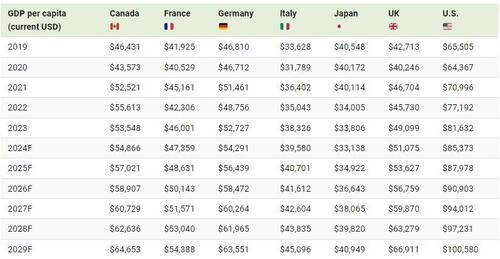
GDP per capita takes the total economic output of a country in a year, and divides it by the total population, providing a measure of a country’s economic performance and living standards on a per person basis.
In this graphic, Visual Capitalist's Marcus Lu visualized GDP per capita for G7 nations, from 2019 to 2029 (forecasted). All figures come from the International Monetary Fund (IMF), and are as of April 2024.
Data and Key Takeaways
The data we used to create this graphic can also be found in the table below.
From this data, we can see that the U.S. has managed a very strong post-COVID recovery relative to its G7 peers. While Canada also saw a strong resurgence in 2021 and 2022, its GDP per capita actually fell in 2023.
This is attributed to the country’s high levels of immigration in 2023, which helped boost population by 3.2% (1,271,000 people). Because this increase outpaced economic growth, Canada’s per capita output decreased.
Looking towards the future, the IMF believes that the U.S. will reach a GDP per capita of $101,000 by 2029, which is significantly higher than any other G7 nation. It also believes that the UK will perform well in the second half of this decade, climbing from fourth to second place among this peer group of countries.
If you enjoyed this post, be sure to check out Ranked: The Top 6 Economies by Share of Global GDP (1980-2024).
GDP per capita takes the total economic output of a country in a year, and divides it by the total population, providing a measure of a country’s economic performance and living standards on a per person basis.
In this graphic, Visual Capitalist’s Marcus Lu visualized GDP per capita for G7 nations, from 2019 to 2029 (forecasted). All figures come from the International Monetary Fund (IMF), and are as of April 2024.
Data and Key Takeaways
The data we used to create this graphic can also be found in the table below.
From this data, we can see that the U.S. has managed a very strong post-COVID recovery relative to its G7 peers. While Canada also saw a strong resurgence in 2021 and 2022, its GDP per capita actually fell in 2023.
This is attributed to the country’s high levels of immigration in 2023, which helped boost population by 3.2% (1,271,000 people). Because this increase outpaced economic growth, Canada’s per capita output decreased.
Looking towards the future, the IMF believes that the U.S. will reach a GDP per capita of $101,000 by 2029, which is significantly higher than any other G7 nation. It also believes that the UK will perform well in the second half of this decade, climbing from fourth to second place among this peer group of countries.
If you enjoyed this post, be sure to check out Ranked: The Top 6 Economies by Share of Global GDP (1980-2024).
Loading…





